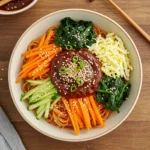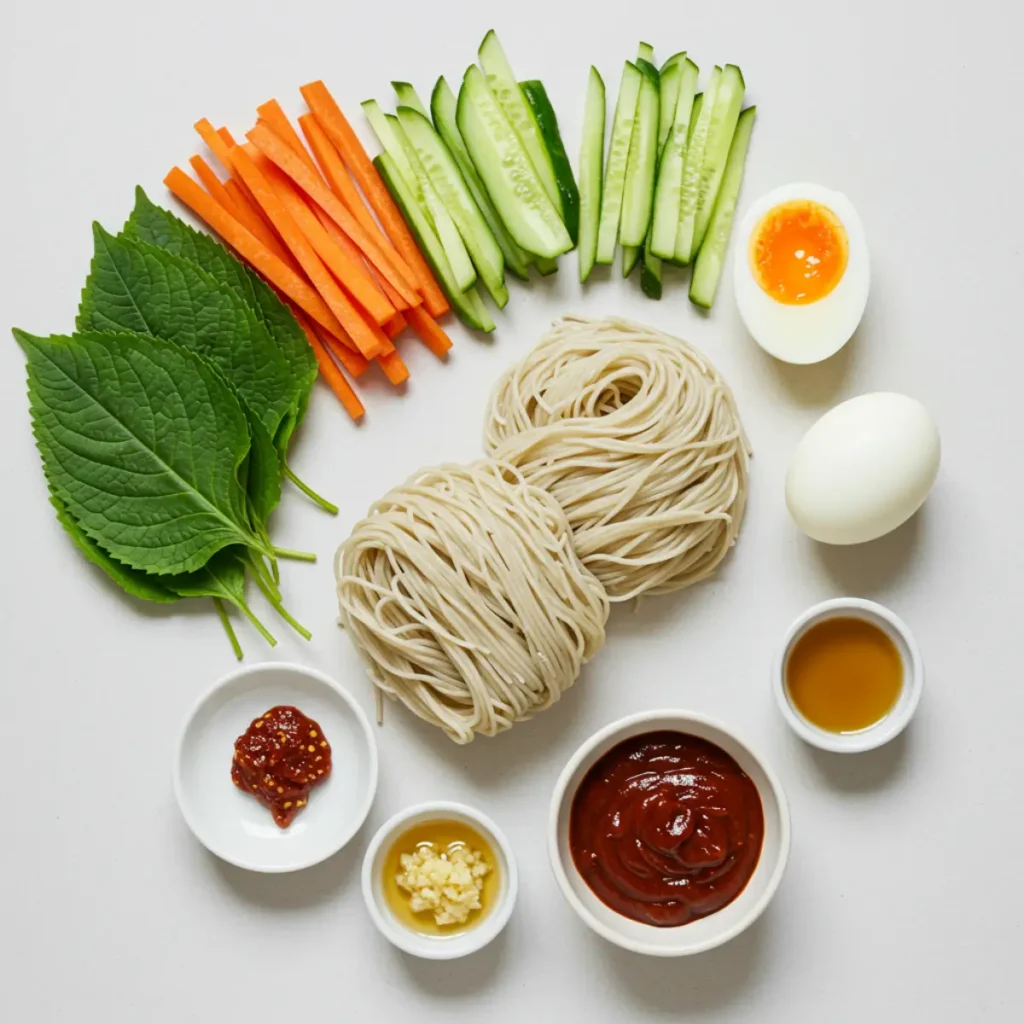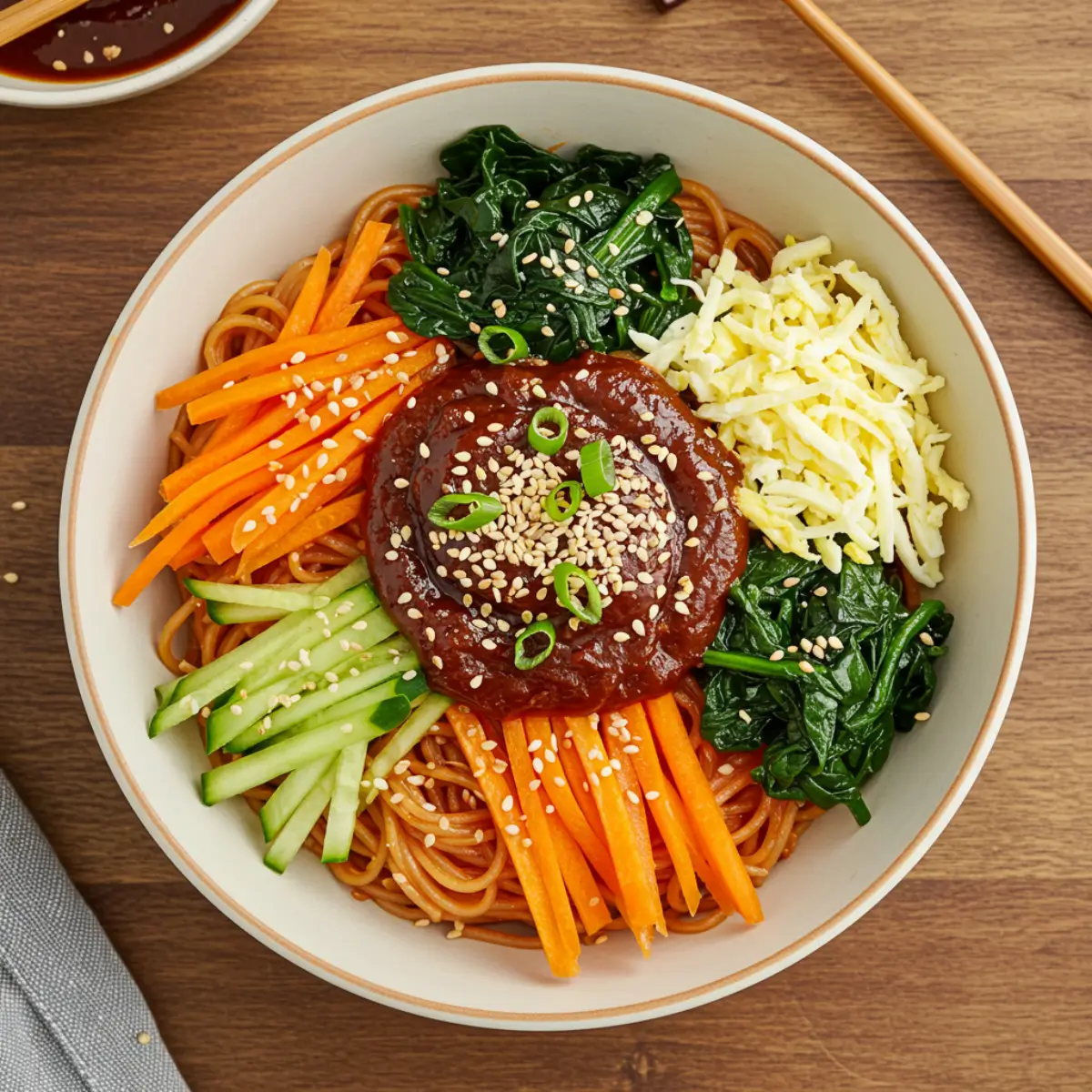Bibim recipe lovers know this dish hits all the right notes—spicy, sweet, tangy, and refreshing. Growing up in Texas, summer meals had to be cold and satisfying. When I first tasted bibim guksu at a Korean friend’s gathering, it instantly reminded me of backyard cookouts—only with a zippy, chili paste kick I couldn’t forget. Since then, this bibim recipe has become a go-to in my kitchen when I need something quick, light, and packed with flavor. In this post, I’ll guide you through the best bibim noodle variations, whether you’re after a classic bibim guksu recipe or a hearty bibim bowl.
Table of Contents
Bibim Recipe Origins: A Fresh Summer Favorite with a Personal Twist
Bibim recipe and why it lives in my kitchen every summer
The first time I made my own bibim recipe, I didn’t expect it to become a summer staple. But once you feel that sweet-spicy hit of gochujang against cold, slippery noodles, there’s no turning back. Bibim translates to “mixed,” and that’s the joy of it. You mix sauce, texture, and color until the bowl feels alive.
With three kids and a full schedule, I need recipes that balance ease and nourishment. Bibim guksu recipe is one of those golden finds—it’s ready in under 20 minutes and still manages to taste like something you’d get at a top-tier Seoul noodle bar. Even better, the base ingredients are clean and vibrant: somyeon noodles, fresh cucumber, a boiled egg, and that irresistible Korean chili paste sauce.
I love playing with versions of this dish. Sometimes I lean into the bibim naengmyeon recipe when I crave chewiness. Other times, I pile it high like a bibim bowl with quinoa and leafy greens. The foundation stays the same: crisp produce, cool noodles, and a sauce that wakes up your taste buds.
On especially hot days, I’ve even paired this dish with cooling teas like my dandelion root tea for weight loss, creating a lunch that refreshes and satisfies.
A moment that sold me on bibim forever
One summer evening, I served my bibim noodle recipe to friends who had never tried Korean food. They cleaned their plates and begged for more. That was my “aha” moment—I realized that this dish wasn’t just a personal favorite. It was universally lovable. Since then, I’ve included it in my summer rotation along with globally-inspired meals like this low-carb kung pao chicken recipe to keep things exciting and wholesome.
Print
Bibim Recipe
- Prep Time: 10 minutes
- Cook Time: 10 minutes
- Total Time: 20 minutes
- Yield: 2 servings
- Category: Main Dish
- Method: Boiling
- Cuisine: Korean
- Diet: Vegetarian
Description
A vibrant Korean bibim recipe using chilled noodles, gochujang sauce, and fresh vegetables for a bold, quick, and healthy meal.
Ingredients
- 4 oz somyeon noodles
- 1 boiled egg
- 1/2 cucumber, julienned
- 1/2 carrot, julienned
- 1 tbsp gochujang
- 1 tsp sesame oil
- 1 tsp rice vinegar
- 1 tsp honey or maple syrup
- 1 tsp toasted sesame seeds
Instructions
- Boil somyeon noodles, rinse under cold water.
- Mix gochujang, sesame oil, vinegar, and sweetener for sauce.
- Arrange noodles in bowl, top with veggies and sliced egg.
- Drizzle sauce generously.
- Garnish with sesame seeds and serve cold.
Notes
- You can substitute with soba or zucchini noodles.
- Adjust spice level by increasing or decreasing gochujang.
Bibim Guksu Recipe: Light, Spicy, and Addictive

Bibim recipe variation: Bibim guksu for a chilled, fiery meal
When it comes to a lighter bibim recipe that still packs flavor, bibim guksu is my top pick. This chilled noodle dish uses thin somyeon noodles tossed in a bold, spicy-sweet sauce made with gochujang, sesame oil, rice vinegar, and just a hint of sweetness. It’s the ultimate quick-fix for those moments when I want something refreshing but still crave deep flavor.
What sets the bibim guksu recipe apart is its simplicity. Once you boil and rinse the noodles under cold water, you toss everything in a bowl—crisp cucumber, shredded carrots, and a jammy soft-boiled egg. It’s vibrant, quick, and deeply satisfying. I often prep a jar of the sauce ahead of time so I can whip up this meal in less than 15 minutes on busy weekdays.
Adding fermented kimchi or even pickled radish elevates it further, giving each bite a complex flavor pop. For a more filling twist, I sometimes pair it with protein-rich sides like this low-carb kung pao chicken recipe or a cooling detox sipper like my turmeric weight loss drink.
Bibim recipe meets healthy Korean comfort
The beauty of the bibim recipe family lies in its balance. The heat of gochujang awakens your senses, while the raw veggies cool you down. I love how the bibim guksu version fits effortlessly into my wellness-focused meals—it’s naturally low in fat and high in flavor. Plus, it’s easy to adjust the spice level for kids or spice-sensitive guests.
Bibim guksu is proof that comfort food doesn’t have to be heavy. It’s clean, flavorful, and deeply rooted in Korean tradition. Just like the yopokki recipe I love for cozy evenings, this dish shows that bold doesn’t have to mean complicated.
Bibim Recipe Twist: Bibim Naengmyeon for a Chewy, Cool Kick
Bibim recipe variation: Bibim naengmyeon’s icy bite and satisfying chew
If you’ve tried a bibim recipe before but never had bibim naengmyeon, get ready for a game-changer. Unlike the light, wheat-based noodles in bibim guksu, bibim naengmyeon features buckwheat noodles with a uniquely chewy texture. It’s traditionally served cold—often even over ice—and tossed in a bright red, gochujang-forward sauce that clings beautifully to every noodle strand.
This bibim recipe version shines especially on hot days when your body craves something cooling but hearty. The cold broth isn’t always included in the bibim version of naengmyeon, so the sauce becomes the star. It’s bold, tangy, a little sweet, and finishes with that classic Korean heat that keeps you reaching for another bite.
I often pair this style of bibim recipe with sliced Asian pear, boiled egg, and cucumber matchsticks. For deeper flavor, I’ll sometimes add a splash of vinegar or a spoonful of my dandelion root tea concentrate for its detoxifying kick—it’s a subtle but welcome enhancement.
Bibim recipe perfection: when texture, chill, and spice collide
What makes this bibim recipe such a standout is how it combines clean ingredients with satisfying textures. The chewiness of the noodles is unforgettable—it keeps you grounded in each bite, unlike lighter versions like bibim guksu. I find that this version sits nicely alongside more savory dishes like my Peru lomo saltado recipe, offering contrast without heaviness.
If you’re experimenting with Korean cooking, bibim naengmyeon is a must-try bibim recipe that feels gourmet without the fuss. It brings bold flavor, natural coolness, and that satisfying mix of sweet-spicy that bibim dishes are known for. Once you try it, you’ll understand why this version has earned its own spotlight in Korean summer cuisine.
Bibim Recipe Bowl: Build-Your-Own Comfort, the Nourishing Way
Bibim recipe turned bowl: custom, hearty, and weeknight-friendly
If you’re looking for a versatile take on the classic, the bibim recipe bowl is your new best friend. Think of it as a Korean-inspired nourish bowl where you get to layer textures, flavors, and nutrients. While traditional bibimbap is served warm with rice and gochujang, the bibim bowl recipe gives you freedom to go grain-free, high-protein, or fully plant-based.
At home, I start with a base—sometimes brown rice, sometimes quinoa, and when I want a low-carb version, I go for shredded cabbage or cauliflower rice. Then I build it up: sautéed mushrooms, kimchi, steamed spinach, crisp carrots, and a soft-boiled egg. Drizzle with the same spicy sauce from your go-to bibim recipe, and you’ve got a deeply satisfying meal.
This bowl-style bibim recipe is perfect when I want something filling yet energizing. It’s also super customizable for family dinners. One kid wants tofu, another wants shredded chicken, and I might toss in some spicy shrimp. Everyone gets their own version, but we’re all enjoying a nourishing bibim recipe meal.
Bibim recipe bowls pair well with feel-good recipes
I often round out these bowls with sides or drinks that keep digestion and energy in check. A glass of my mounjaro coffee recipe for weight loss gives a gentle lift, while sipping on dandelion root tea before or after eating keeps things light and balanced.
And on nights when I’m craving more global flavor, I love pairing my bibim bowl with something bold like this Peru lomo saltado recipe—it’s a fusion moment that somehow works perfectly.
A bibim recipe bowl isn’t just a dinner. It’s a smart, family-friendly way to eat more whole foods, try new vegetables, and play with spicy-sweet balance—all without spending hours in the kitchen. Whether you’re craving variety or ease, this bibim recipe variation covers both.
Bibimbap and Its Wholesome Korean Legacy
Bibim comfort: why bibimbap stands the test of time
When it comes to the most recognized bibim recipe worldwide, bibimbap is the dish that instantly comes to mind. It’s hearty, colorful, and endlessly satisfying. At its core, bibimbap is a bibim recipe built around warm rice, topped with vibrant vegetables, a fried egg, and spicy-sweet gochujang sauce. Each bite is a flavorful celebration of balance and harmony.
Bibimbap literally translates to “mixed rice,” and it captures the spirit of every bibim recipe I’ve shared so far. What I love about this dish is that it’s more than food—it’s a cultural experience. With its medley of textures and flavors, the bibimbap-style bibim recipe becomes a complete meal that feels both comforting and energizing.
At home, I build my bibimbap bibim recipe with cooked short-grain rice, sautéed zucchini, bean sprouts, spinach, mushrooms, and carrots. A perfectly runny egg goes on top, followed by a generous dollop of homemade gochujang sauce. Then comes the fun part—mixing it all together. That moment, the messy mix of colors and textures, is the magic of any good bibim recipe.
Bibim recipe meets modern meal prep
The best part? This bibim is ideal for meal prepping. I’ll make extra rice and veggies, then store them separately. When I need a fast lunch or post-yoga dinner, I warm things up and assemble a nourishing bibim recipe bowl in minutes.
To keep my meals balanced, I often pair bibimbap with gut-friendly drinks like my turmeric weight loss recipe or this satisfying yopokki recipe as a savory side.
This timeless bibim recipe proves that eating well doesn’t have to be complicated. A bowl of bibimbap nourishes deeply—with flavor, tradition, and intention—and it’s one bibim recipe I’ll never get tired of making.
Bibim Recipe Noodles: Quick, Flexible, and Flavor-Forward
Bibim recipe go-to: why bibim noodle recipe saves busy weeknights
The most effortless bibim recipe you’ll ever make? The bibim noodle recipe. This variation is my weeknight rescue meal when I want something fast, flavorful, and packed with punch. It’s a simple, mix-and-eat dish made with thin noodles—like somyeon, soba, or even gluten-free options—coated in a rich gochujang-based sauce. It’s proof that a satisfying bibim doesn’t have to take hours.
What makes the bibim noodle recipe so convenient is its flexibility. You can stick with tradition or totally make it your own. I’ve made versions with cold zucchini noodles, bean-thread noodles, and even protein-enriched pasta when I want a post-workout bibim that fuels and satisfies.
The best part? Once the noodles are cooked and rinsed, everything else is raw or already prepped. Julienne some veggies, toss in greens, and add your sauce. That’s it. A little sesame oil and toasted seeds take it from good to incredible. When I want to add protein, I’ll throw in sliced eggs or top it with a bit of my protein broccoli bread recipe for a fun, crunchy side.
Bibim recipe essentials for the always-hungry and health-focused
For busy moms or anyone looking to keep meals intentional and healthy, this bibim recipe noodle style is a must-have in the kitchen. I pair it with my beetroot detox drink recipe to keep the meal light but energizing. Together, they make an ideal combo for hot days, quick lunches, or a no-fuss dinner.
This bibim noodle recipe reminds me that real food can be fast. With just a few staples and a solid bibim recipe sauce, I can feed myself and my family something nourishing in under 20 minutes—and that’s a win I’ll take any day.
FAQs
What is bibim guksu made of?
Bibim guksu is made of thin wheat noodles (somyeon), gochujang-based sauce, sesame oil, sugar, vinegar, garlic, and toppings like cucumbers, eggs, and carrots. It’s a spicy, chilled noodle dish that’s fast and refreshing.
What is Bibim Naengmyeon made of?
Bibim naengmyeon uses chewy buckwheat noodles tossed in a spicy sauce without broth. It’s typically served cold with toppings like sliced cucumber, boiled egg, Asian pear, and sometimes beef slices.
What is the difference between bibimbap and bibimmyeon?
Bibimbap is a warm rice-based bibim recipe served with sautéed vegetables and egg, while bibimmyeon (or bibim noodles) uses cold noodles and spicy sauce. Both involve mixing ingredients before eating but differ in texture, base, and temperature.
Is bibim guksu healthy?
Yes, bibim guksu is considered a healthy dish. It’s low in fat, high in flavor, and made with nutrient-rich vegetables and fermented chili paste. It’s easily customizable to suit various dietary needs.
Conclusion
The beauty of any bibim recipe lies in its vibrant mix of textures, bold flavors, and adaptability to your lifestyle. From the chewy depths of bibim naengmyeon to the hearty warmth of bibimbap, each version offers a unique experience. Whether you’re planning a refreshing summer dinner or a comforting family lunch, there’s a bibim recipe that fits your mood and schedule.
As a mom who values wholesome, time-saving meals, I keep a few bibim staples in my pantry at all times. The sauces, the noodles, the vegetables—it’s all about having real ingredients ready to nourish. So go ahead and find your favorite version. Mix it. Love it. And make it yours.
Follow us on Pinterest for weekly slow cooker inspiration, or join the conversation over on our Facebook page where fellow food lovers share their favorite comfort meals.





